Industrial Ventilation - 5. Hoods
On this page
What is covered in this document?
Back to topThis document is part of a series of documents on industrial ventilation, and provides general information about hoods.
What is a hood?
Back to topA hood - correctly called a local exhaust hood - is the point where contaminated air is drawn into the ventilation system. The sizes and shapes of hoods are designed for specific tasks or situations. The air speed (velocity) at the hood opening and inside the hood must be enough to catch or capture and carry the air contaminants. To be most effective, the hood should surround or enclose the source of contaminant or be placed as close to the source as possible.
What are the common types of hood?
Back to topThe three common classes of hoods are:
- Enclosing.
- Receiving.
- Capturing.
Enclosing Hood
Enclosing hoods, or "fume" hoods, are hoods surrounding the process or point where the contaminants are generated. Examples of completely enclosed hoods (all sides enclosed) are glove boxes and grinder hoods. Examples of partially enclosed (two or three sides enclosed) hoods are laboratory hoods or paint spray booths. The enclosing hood is preferred whenever possible.
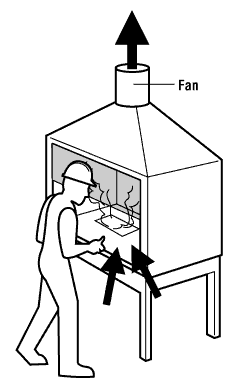
Partially Enclosed Hood
Receiving Hood
These hoods are designed to "receive" or catch the emissions from a source that has some initial velocity or movement. For example, a type of receiving hood called a canopy hood receives hot rising air and gases, as shown in Figure 2. An example is a canopy hood located over a melting furnace.
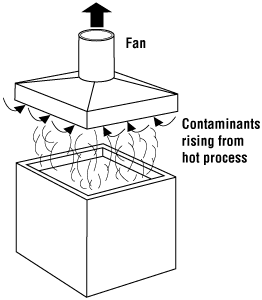
Receiving Hood
Capturing Hood
These hoods are located next to an emission source without surrounding (enclosing) it. Examples are a rectangular hood along the edge of a tank (as shown in Figure 3) or a hood on a welding or grinding bench table (figure 4) or a downdraft hood for a hand grinding bench (figure 5).
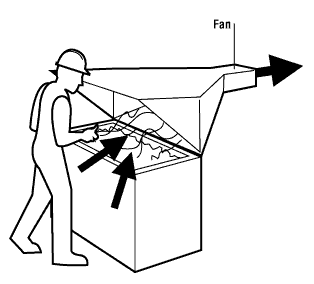
Capturing Hood
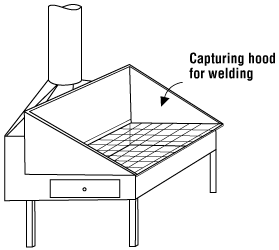
Capturing hood for welding or grinding bench
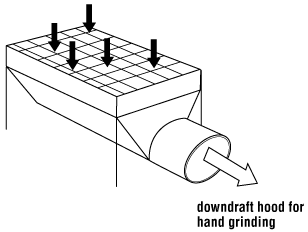
Downdraft Hood for hand grinding
What is meant by "capture velocity"?
Back to topThe ventilation system removes contaminants by "pulling" the air (and the contaminant) into the exhaust hood and away from the worker or the source. Airflow toward the hood opening must be fast or high enough to "catch and transport" the contaminant until it reaches the hood and ducts. The required air speed is called the "capture velocity".
Any air motion outside of the hood and surrounding area may affect how the air flows into the hood. The ventilation system will require a higher airflow speed to overcome air disturbances. As much as possible, the other sources of air motion should be minimized or eliminated for the ventilation system to work effectively.
Common sources of external air movement include:
- Thermal air currents, especially from hot processes or heat-generating operations.
- Motion of machinery such as grinding wheels, belt conveyor, etc.
- Material motion such as dumping or filling.
- Movements of the operator.
- Room air currents (which are usually considered 50 fpm (feet per minute), but may be much higher).
- Rapid air movement caused by spot cooling and heating equipment.
Where the contaminant is released with practically no other air currents in a room, the recommended capture velocity is generally around 0.5 m/s (100 feet per minute (fpm)). How fast is 100 fpm? Blowing lightly on your hand so that you can just barely feel air movement is about 100 fpm. It is easy to see how it will take very little air movement from other sources to affect how well a hood can capture contaminants. (See Figure 6).
In situations, such as grinding for example, where the contaminants are released in the air at high speed and where there is a rapid air circulation in the room, the necessary capture velocity may be 5 to 10 times higher.
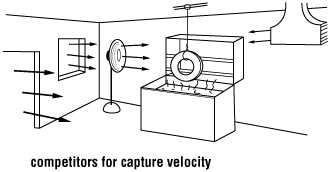
Competitors for Capture Velocity
In the case of partially enclosed hoods, the capture velocity is measured at the hood opening and it is known as face velocity.
What are the general rules for hood design?
Back to topThe shape of the hood, its size, location, and rate of airflow each play an important role in design considerations. Each type of hood has specific design requirements, but several general principles apply to all hoods:
- The hood should be placed as close as possible to the source of contamination, preferably enclosing it. The more completely enclosed the source is, the less air will be required for control. The required airflow rate varies with the square of the distance from the source as shown in Figure 7.
- The air should travel from the source of contaminant and into the hood with enough velocity (speed) to adequately capture the contaminant.
- The hood should be located in a way that the operator is never between the contaminant source and the hood.
- The natural movement of contaminants should be taken into consideration. For example, a hood should be placed above hot processes to trap rising gases and heat. A grinding wheel or woodworking machine should be equipped with a partial enclosure to trap the flying particles where they spin off.
- Flanges or baffles should be used around the hood opening to increase the capture effectiveness and reduce ventilation air requirements.
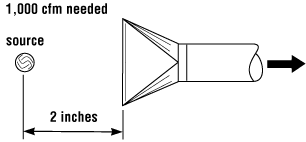
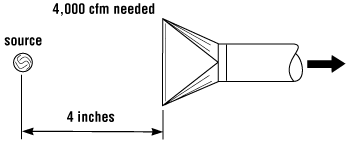
If a hood is moved from two inches away from a source to four inches away (twice the distance), the airflow required to provide the same degree of capture will be four times greater.
How do I know which type of hood is adequate for the process?
Back to topThe hood should be selected according to the characteristics of the process to ensure that the worker’s exposure to airborne contaminants is minimal.
The following table contains a comparison of the three types of hoods.
| Table 1 Comparison of Hoods | |||
|---|---|---|---|
| Capturing and Receiving Hoods | Enclosing Hoods | ||
| Recommended Use | Disadvantages | Recommended Use | Disadvantages |
| Contaminant released with no speed Contaminant released at locations with minimal speed cross-draft conditions Note: the source must be located within the effective range of the hood | Performance is reduced by:
| Generation of high amount of contaminant Very toxic contaminant Contaminant released with high speed High-speed cross-draft conditions All other conditions where capture / receiving hoods are effective | High cost More complicated design Occupy more of the workplace space |
How do I know if a hood is working as designed?
Back to topThe ASHRAE 110 (test) is the recognized method for evaluating the performance of fume hoods. A qualified person should do the testing.
- Fact sheet last revised: 2023-06-21

